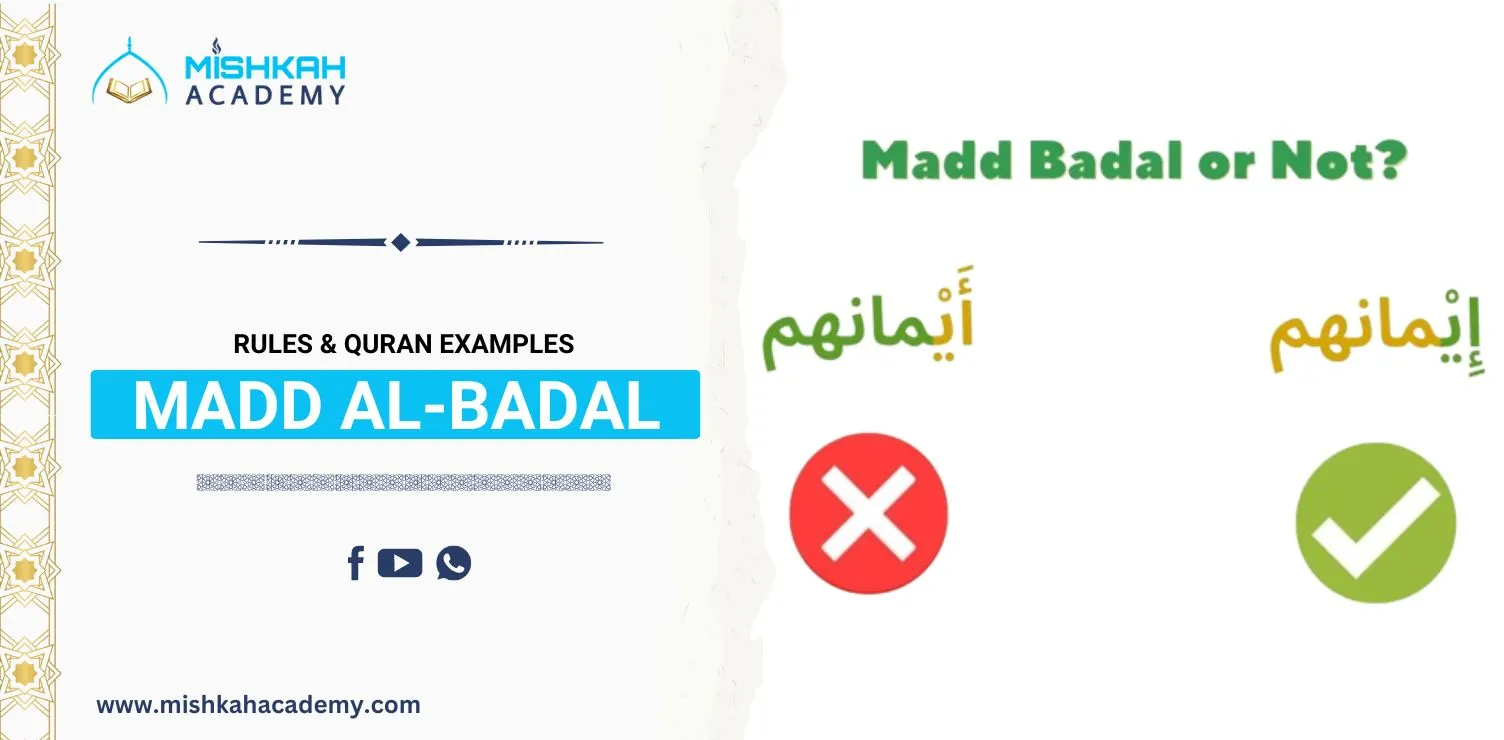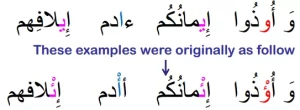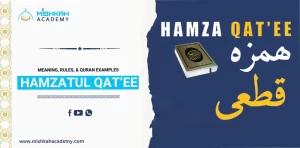Madd is a very important term in Quranic recitation and tajweed (Quranic pronunciation standards). In Arabic, “Madd” (مد) means “elongation” or “extension” of the sound of specific letters. A proper understanding of Quran reading rules is essential to mastering Madd, as there are several types, each with its own guidelines. Madd Badal is one such example. In this blog, we will look at the concept, norms, and examples of Madd Badal, with an extra focus on its use in the Quran.
What is Madd Badal?
Table of Contents
ToggleMadd Badal (مد البدل) happens when a Hamzah (ء) is followed by a Madd letter (ا, و, or ي) in the same word, with the Hamzah coming first. This sort of Madd is unique in that it substitutes or replaces the original sound. The Madd letter replaces the Hamzah, elongating the sound in the absence of another Hamzah after it.
The name Badal means “substitution” or “replacement” in Arabic, which captures the core of this Madd. Instead of having a natural Hamzah sound, the letter is lengthened by the presence of a Madd letter.
Rules for Madd Badal
The main rules governing Madd Badal are basic but vital to follow:
1: In Madd Badal: a Hamzah must come before one of the three Madd letters (ا, و, or ي) in the same word.
Madd Alif (ا) is preceded by a Hamzah and Fathah (ـَ).
Madd Waw (و) is preceded by a Hamzah and Dammah (ـُ).
Madd Yaa (ي) is preceded by a Hamzah and Kasrah (ـِ).
2: No Hamzah After Madd Letter: Madd Badal cannot occur if there is a second Hamzah in the same word after the Madd letter.
3: Elongation Duration (Timing): Madd Badal is typically elongated for two counts (harakah), which implies the sound is stretched over two vowels. It does not expand beyond this.
4: Same Word Requirement: The Hamzah and Madd letters must be in the same word. If the Madd letter occurs in another word, it is no longer considered Madd Badal.
To better comprehend this form of madd, let us look at some examples:
Madd al-Badal is a form of prolongation (madd) in Tajweed in which a vowel letter (madd letter) follows a Hamzat al-Qat’ (glottal stop). It is expanded by two counts (harakat). The following are some examples of Madd al-Badal:
آمَنَ: The phrase Hamzat al-Qat’ is followed by an alif (أ).
إيمان: Hamzat al-Qat’ is followed by a ya (ي).
أوتوا: Here, the Hamzat al-Qat’ is followed by a waw (و).
N0te: Enroll in Online Tajweed Course With Mishkah Acadmey Quran tutors to learn how to apply Madd Al Badal in your quran recitation properly.
Start Your Quran Journey NowHow To Apply Madd Al Badal With Quran Examples
The Quran has many instances of Madd Badal. To further appreciate its use in recitation, consider the following essential instances from various Surahs:
Example 1: Surah Al-Baqarah (2:62)
Word: آمَنُوا (Àmanoo).
Explanation: “آمَنُوا” contains Madd Badal because the Hamzah (ء) comes before the Madd letter Alif (ا). The Hamzah has a Fathah (ـَ) and no Hamzah after the Madd letter, hence it is elongated by two counts.
Example 2: Surah Al-Fatihah (1:7)
Word: إِيمَانًا Eemānan.
Explanation: The phrase “إِيمَانًا” also refers to Madd Badal. The Hamzah (ء) is followed by Madd Yaa (ي), with a Kasrah (ـِ). This results in an elongated sound of two counts.
Example 3: Surah Al-Kahf (18:1)
Word: آيَاتٍ (Āyātin).
Explanation: In “آيَاتٍ”, the Hamzah precedes Madd Alif. Because there is no Hamzah following the Madd letter, it qualifies as Madd Badal and is recited with an extension of two counts.
Example 4: Surah Maryam (19:73)
أُولَئِكَ (Ūlā’ika)
Explanation: In the word “أُولَئِكَ”, the Hamzah has a Dammah (ـُ) and precedes Madd Waw. This is an obvious case of Madd Badal.
When Not To Apply Madd Badal
To better understand the examples and the rule, let’s see an example in which case this rule is not applied. The word (أَيْمَانَهُمْ) in the Qur’an does not contain Badal and its pronunciation is “Aymaanahum”.
As you can see in the red-shaded section, Hamza’s vowel is the Fatha before the letter Mad Yaa. For two beats to be heard, the hamza movement must be a Kasrah.
Why is Madd Badal Important in Tajweed?
Madd Badal is significant because it contributes to the flow and harmony of Quranic recitation, making it sound more melodious and balanced. By elongating the sound of the Madd letter, the reciter can correctly pronounce the Hamzah and Madd combination without breaking the natural pace of the recitation.
Examples of Madd Badal in Quranic verses
To underline the concept, let’s look at some additional Madd Badal examples from prominent Quranic verses.
Surah Al Baqarah (2:285)
The phrase: “آمَنَ الرَّسُولُ بِمَا أُنزِلَ إِلَيْهِ مِنْ رَبِّهِ وَالْمُؤْمِنُونَ”
Word: آمُنَ (Āmana).
Explanation: The word “آمَنَ” has a Hamzah and a Fathah, followed by Madd Alif, indicating Madd Badal.
Surah al’Imran (3:52)
The phrase: “فَلَمَّا أَحَسَّ عِيسَىٰ مِنْهُمُ الْكُفْرَ قَالَ”
Word: Aḥassa.
Explanation: The Hamzah in “أَحَسَّ” is followed by Madd Alif, meeting the criterion of Madd Badal.
Surah Al Furqan (25:25)
The phrase: “وَيَوْمَ تَشَقَّقُ السَّمَاءُ بِالْغَمَامِ”
Word: السَّمَاءُ “As-samā'”
Explanation: This word contains a Hamzah followed by a Madd Alif and a Madd Waw, making it a textbook example of Madd Badal.
Common Mistakes in Madd Badal Recitation
While Madd Badal is one of the easier kinds of Madd, reciters might make the following typical mistakes:
Over-elongating the Madd: Some reciters incorrectly extend Madd Badal for more than two counts. This is incorrect and it should be avoided.
Skipping the Elongation: Similarly, skipping the elongation entirely and pronouncing it as a normal letter is a mistake.
Misidentifying Madd: Madd Badal is sometimes confused with other varieties of Madd, such as Madd Muttasil (where Hamzah follows the Madd letter in the same phrase). To recite correctly, you must first understand the difference.
Key Takeaway: Madd Badal arises when a Hamzah comes before a Madd letter in the same word.
The elongation continues for two counts.
Examples of Madd Badal include words like “آمَنُوا” and “إِيمَانًا“.
The proper application of Madd Badal improves the beauty and flow of Quranic recitation.
Understanding and effectively implementing Madd Badal is not only a strategy to improve recitation, but also to connect intimately with the Quran and its holy language.
Conclusion
At Mishkaha Academy, we emphasize the importance of mastering Tajweed rules, including Madd Badal, specially in for kids through our Quran classes for kids. Madd Badal is a crucial Tajweed guideline that ensures the proper pronunciation and smooth extension of sounds during Quranic recitation by replacing Hamzah with a Madd letter. By following the principles of Madd Badal, students can maintain the beauty and accuracy of the Quran’s recitation. Our online Quran classes at Mishkaha Academy are designed to help young learners excel in their recitation while staying true to the correct pronunciation of Allah’s verses.
Start Your Quran Journey Now






